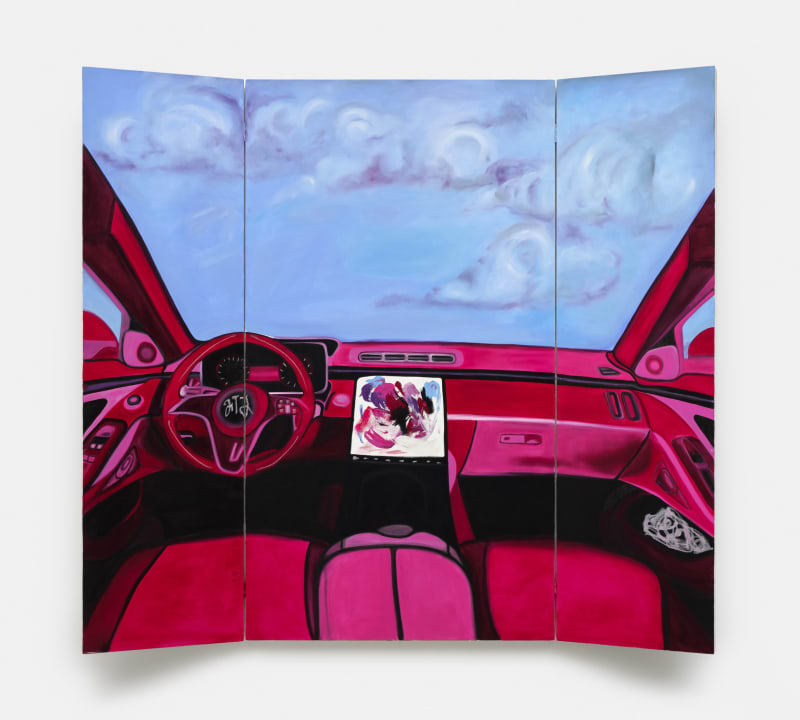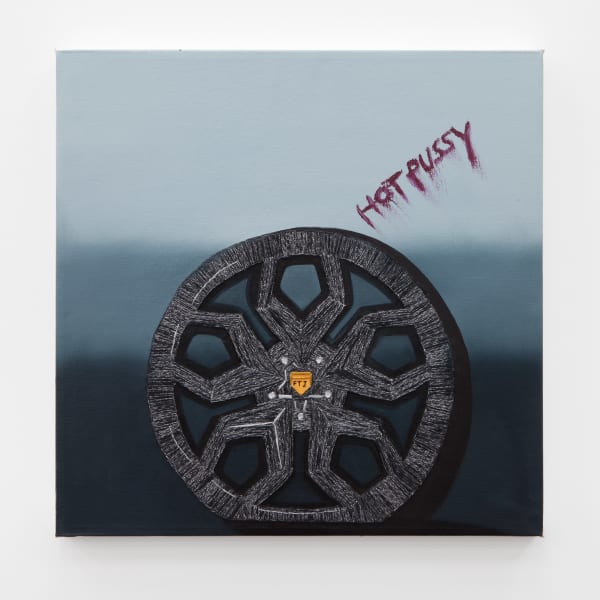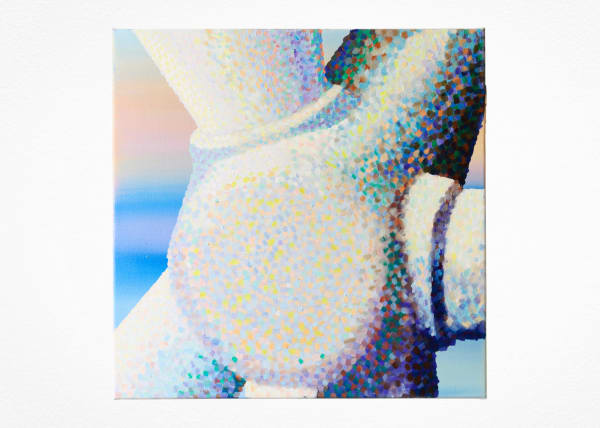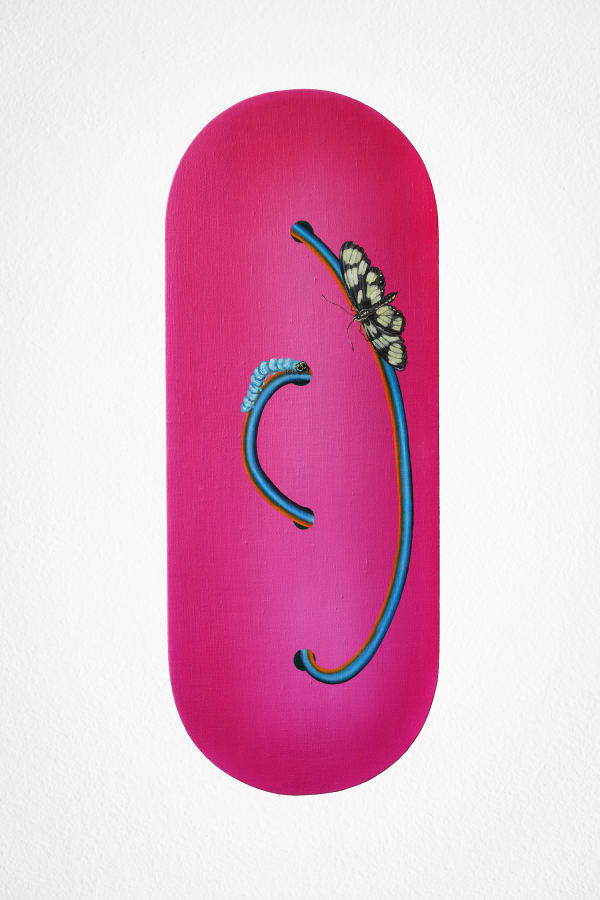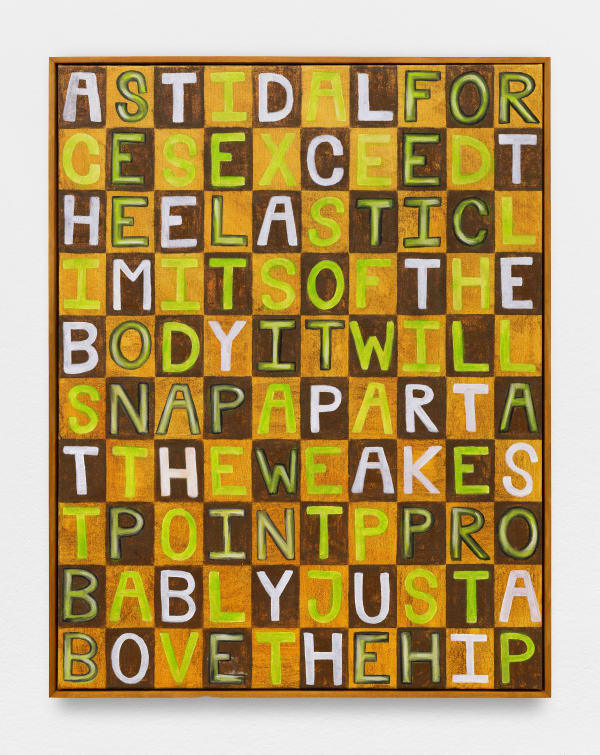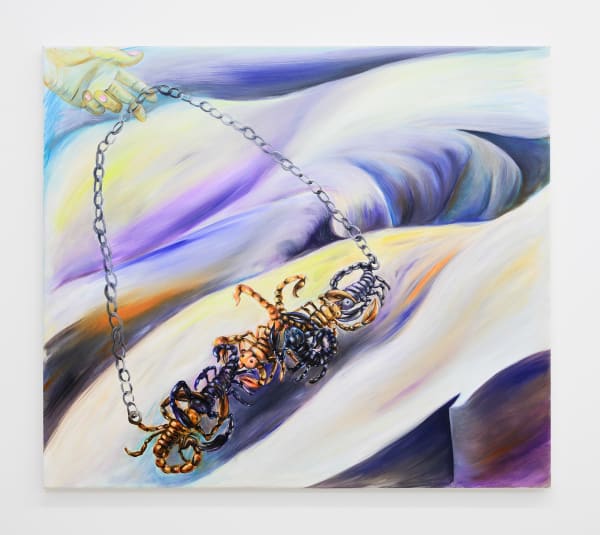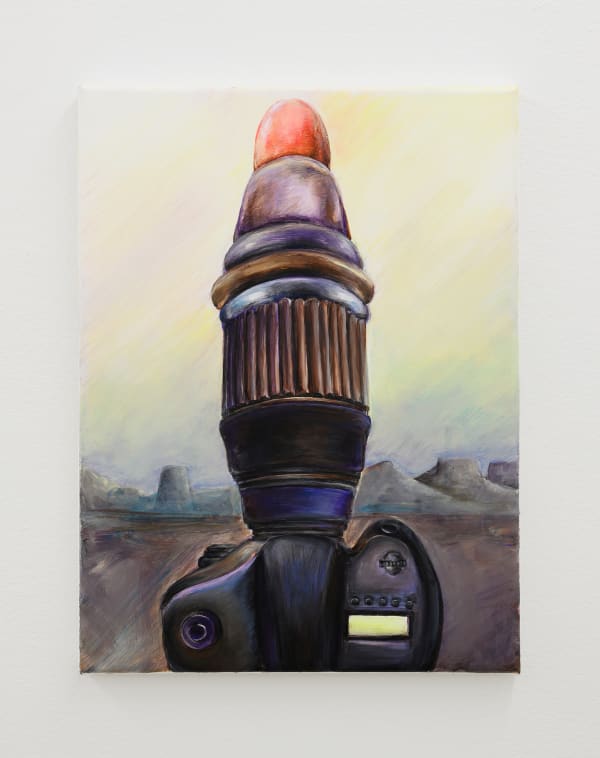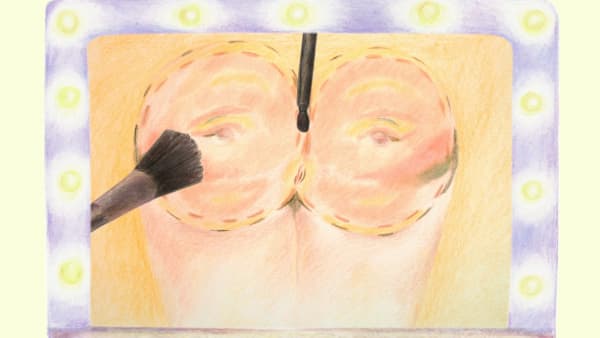draw a door in the wall and slip through it: Astrid Kajsa Nylander, Beatrice Marchi, Frieda Toranzo-Jaeger, Tanja Nis-Hansen
Curated by Astrid Kajsa Nylander.
“Inspired by the autistic and infantile energy that sprouts and resists the processes of discipline and control of the body, affect, and sexuality, this manifesto is a theoretical and poetic attempt to do what is done in cartoons: draw a door in the wall of sexual and gender oppression and escape through it.” [1]
After receiving a quote from P. Preciado, a Spanish philosopher and gender theorist, Astrid reached out to me to pen a text for an exhibition showcasing the artworks of Beatrice Marchi, Tanja Nis-Hansen, Frieda Toranzo-Jaeger, and Nylander herself. Initially, Nylander connected with her fellow artists during her studies in Hamburg under the mentorship of Jutta Koether, a prominent contemporary German female painter. Koether's expansive and open approach to art challenges conventional notions of painting by delving into performance, film, music, and collaborative projects. This broader concept of painting aligns with the diverse artistic expressions presented by each participant in Stockholm.
Nis-Hansen, Marchi, Nylander and Toranzo-Jaeger are all born by the end of 1980s and belong to a generation of artists that is interested in approaching painting both as conceptual and political. While each of the women enter this discussion with their own distinctive artistic voices they all share a common interest in expressing ideas of hybridity, sexuality and autonomy. While discussing the idea of drawing a door in the wall and slipping through it, Astrid also recounted an intriguing occurrence from the night before the four women began brainstorming for the show. Remarkably, each of them had experienced an erotic dream on that particular night. They chose to interpret this extremely unusual occurrence as a sign that should influence the concept for the show.
During our initial discussion about my text contribution, Astrid and I conversed while I was in Vienna, my hometown. Being in close proximity to Freud's apartment, I felt compelled to revisit his theories on erotic dreams.
From a Freudian perspective dreams are considered a pathway to the unconscious mind where erotic content has significant psychological meaning. Dream imagery and symbols related to sexuality can represent repressed desires, conflicts or unresolved issues in a person’s life. While Freud seems to focus on the aspect of repression connected to the erotic dream, Preciado’s thinking frames it as a powerful site for the subversion and transformation of normative sexual and gender paradigms. He advocates for a reimagining of gender and sexuality beyond the binary framework and argues that erotic dreams can be a space for exploring and expressing a more fluid and inclusive sense of self and desire.
While I was reading the Countersexual Manifesto one passage about sexuality stuck with me: “Sexualities are like languages: they are complex systems of communication and reproduction of life. As languages, sexualities are historical constructs with common genealogies and biocultural inscriptions. Like languages, sexualities can be learned. Multiple languages can be spoken.”[2]
As I write this text, I find myself contemplating the possibility of drawing a parallel between the notion of sexuality as a language that can be learned and the medium of painting. Both domains have, until very recently, been marked by the dominance of restrictive dogmas within the archives of history. While painting until the 1960s was either conceptual or figurative, contemporary artists investigate figuration as a means of exploring the conceptual potential of painting.
It has broken away from its historical association with bourgeois representation and is a living antithesis, a grotesque ever-changing amalgamate of figuration and concept that in the case of this show embraces fragmentation, caricature, satire, hyperreality, images of abjection and derangement.
Within Tanja Nis-Hansen's artwork, the notion of diverse painterly languages is realized in a very literal sense: “C”, 2022 initially belongs to a larger installation titled “Employee of the Month” consisting of five more letters, which together form the word “crumbs”. Initially shown for a site specific installation at the Vestjyllands Kunstpavillon, Videbæk in Denmark, the work draws inspiration from Julia Stephen's book "Notes from Sick Rooms," which addresses illness with clarity and humor. Nis-Hansen creates a catchphrase that vividly conveys the often-overlooked pain of a sick body, emphasizing the small but significant inconvenience of crumbs. Her style is deeply influenced by theater and stage design, which is evident not only in the spatial arrangement on the canvas but also in an overall "theatrical" style of representation.
Beatrice Marchi's artistic journey has always been marked by versatility and collaboration, spanning a range of disciplines from drawing and painting to animation, performance, video, and sound. In a recent piece titled "Salame" (2023), the artist brought together two components symbolizing the body of a camera and its extended lens. Together with the title, the work challenges an immediate sexualized reading of the mechanical tool. This method of portraying sexuality through technology aligns with Preciado's concept of a "techno-self." Preciado explores the idea of this techno-self as a means to articulate diverse expressions of sexuality as mentioned earlier. In this perspective, technology is not confined to a mechanical understanding but extends into the domain of medicine, playing a role in shaping gender expressions.
However, let's confine ourselves to the framework of depicting sexuality and technology as presented in the exhibition. Despite „Salame“ being a rather uncomplicated representation of a sexualized object, the exploration of the relationship between the viewer and the viewed subject is inherent in it.
The artwork primarily depicts the passionate connection between these two individuals. However, in an era dominated by "selfies," it raises the question of whether this intimate relationship inherently involves two people or is simply a reflection of the self. The erotic relationship to one self appears in an other work of Marchi, which is titled „Amiche Forever“ (2017). In this animated video a female character, possibly the artist herself, gazes into a mirror or an iPad screen, focused on an image, likely her own behind, which takes on an uncanny resemblance to a face.
Examining Astrid Kajsa Nylander's recent series of works, technology is portrayed in a sexualized manner as well. In "Internally Inconsistent" (2023), Nylander delves into the materialized infrastructures that facilitate the generation and dissemination of wind energy and the internet. This exploration started when the artist heard a researcher on Swedish Radio commenting yet another municipality voting against the expansion of wind power by saying that wind turbines could become future attractions to visit. This led Nylander to create paintings turned into objects resembling wind and energy masts, which express this fantasy of a potential future. The latter comes to life through paintings that pulsate with erotic energy which surface through candy-like shapes, psychedelic fluorescent colors, and delicate butterflies. Similarly to Marchi’s „Salame“, Nylander’s work explores the phallic shapes of communication and simultaneously expresses an interest in the changes of perception onto the idealized image of the landscape which intersects with the technological additions made by humans.
Frieda Toranzo Jaeger's paintings also prominently feature technology. Her artworks often follow the triptych format, traditionally used for religious devotion. She reinterprets this format to align with a historical tradition dominated by male artists. Many of her pieces focus on car interiors, typically seen as a masculine domain associated with control. Jaeger transforms these spaces into feminine realms. Her depictions feature futuristic, driverless, and electric cars. On one hand, these partially folded triptychs resemble sports car doors that open vertically upwards, while simultaneously, this formal expression could also symbolize a vulva. Her pieces not only obscure the portrayal of sexualized objects as an embodiment of our libidinal connection to consumption but more importantly involve a subversive appropriation of this libidinal relationship. She subverts or redefines it through the incorporation of queer image motifs.
At the end of this text, I wonder what lies behind the door alluded to in the exhibition's title. The works of Nis-Hansen, Marchi, Nylander and Toranzo Jaeger show a tantalizing, painterly world in which theatricality, eroticism and subversion collide. Contrary to the dreams the women had at the beginning of this exhibition project, their works challenge us to remain vigilant and attentive to the ways in which invisible economic and technological forces shape our bodies and minds.
Cathrin Mayer, Stockholm, 2023
[1] Paul B. Preciado, Countersexual Manifesto, 2018, Columbia University Press, p. 17.
[2] Ibid, p. 8.
-
 Frieda Toranzo-Jaeger, Feminist review of the Oedipus Complex, 2022
Frieda Toranzo-Jaeger, Feminist review of the Oedipus Complex, 2022 -
 Frieda Toranzo-Jaeger, Hot pussy, 2022
Frieda Toranzo-Jaeger, Hot pussy, 2022 -
 Astrid Kajsa Nylander, Crop #1, 2023
Astrid Kajsa Nylander, Crop #1, 2023 -
 Astrid Kajsa Nylander, Internally inconsistent, 2023
Astrid Kajsa Nylander, Internally inconsistent, 2023
-
 Astrid Kajsa Nylander, Macaoon, 2023
Astrid Kajsa Nylander, Macaoon, 2023 -
 Astrid Kajsa Nylander, pink minijob #7, 2023
Astrid Kajsa Nylander, pink minijob #7, 2023 -
 Astrid Kajsa Nylander, green minijob #6, 2023
Astrid Kajsa Nylander, green minijob #6, 2023 -
 Astrid Kajsa Nylander, Vermilion red minijob, 2023
Astrid Kajsa Nylander, Vermilion red minijob, 2023
-
 Astrid Kajsa Nylander, Apple-Green Minijob #4, 2023
Astrid Kajsa Nylander, Apple-Green Minijob #4, 2023 -
 Tanja Nis-Hansen, C, 2022
Tanja Nis-Hansen, C, 2022 -
 Tanja Nis-Hansen, astidalforcesexceedtheelasticlimitsofthebodyitwillsnapapartattheweakestpointpprobablyjustabovethehip, 2021
Tanja Nis-Hansen, astidalforcesexceedtheelasticlimitsofthebodyitwillsnapapartattheweakestpointpprobablyjustabovethehip, 2021 -
 Tanja Nis-Hansen, Folded hands (I am still a patient girl), 2021
Tanja Nis-Hansen, Folded hands (I am still a patient girl), 2021
